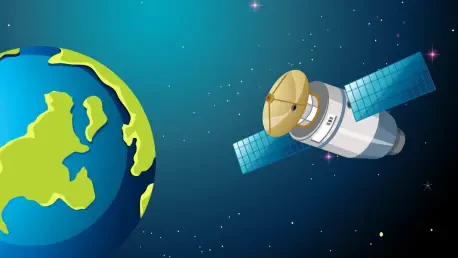In an era where climate change poses unprecedented threats to ecosystems and communities, the role of advanced technology in mitigating these challenges has taken center stage, with satellites playing a pivotal role. Orbiting high above the Earth, they provide a transformative perspective that ground-based systems often cannot match, offering detailed, global-scale data to track environmental shifts. This technology is not just a passive observer but a vital tool in shaping adaptation strategies, helping policymakers and local leaders make decisions grounded in evidence. From capturing the slow creep of desertification to the sudden devastation of floods, satellites reveal patterns that are critical for planning and response. Their ability to monitor vast, remote areas over decades ensures that no corner of the planet is overlooked. This article delves into the profound impact of satellite technology on climate adaptation, exploring its applications across diverse sectors and the innovative ways it integrates with policy frameworks to address a warming world.
Unveiling Global Insights Through Earth Observation
Tracking Changes with Unmatched Precision
Satellites are redefining how climate adaptation is measured by delivering consistent, long-term observations across the entire globe. Unlike traditional ground-based tools that are often limited to specific regions, satellite systems capture data from the most isolated wilderness to densely populated urban hubs with regular updates. Some datasets even extend back over 60 years for certain metrics, creating a historical foundation that allows experts to evaluate how adaptation efforts have progressed or where they’ve fallen short. Whether it’s monitoring shrinking glaciers or erratic rainfall patterns, this technology offers a cohesive view of a fragmented planet. The significance of filling data gaps in areas where conventional methods are impractical cannot be overstated, as it ensures a more comprehensive understanding of climate impacts. This global lens is proving indispensable for identifying trends that might otherwise go unnoticed, providing a clearer picture of the challenges ahead.
Aligning Data with Global Climate Goals
Beyond simply collecting data, satellites are instrumental in turning international climate commitments into tangible, measurable results. They play a crucial role in supporting frameworks such as the Paris Agreement’s Global Goal on Adaptation by contributing to Essential Climate Variables (ECVs), which are key indicators of resilience. These variables help determine how effectively communities, ecosystems, and infrastructure are coping with escalating climate risks. For example, satellite imagery can show whether coastal defenses are holding against rising sea levels or if reforestation efforts are gaining ground. This near-real-time, unbiased information empowers decision-makers to adjust strategies based on solid evidence rather than assumptions. The ability to provide such insights across diverse regions ensures that adaptation efforts are not only reactive but also proactive, addressing vulnerabilities before they become crises. This alignment with global goals underscores the technology’s potential to drive meaningful change on a planetary scale.
Satellites in Action Across Sectors
Agriculture and Food Security
Satellite technology is making a profound difference in agriculture, where it monitors vital aspects like crop water productivity, irrigation efficiency, and shifts in cultivation due to climate pressures. In remote areas where conducting ground surveys is logistically challenging or prohibitively expensive, satellites provide an essential alternative, delivering data that helps farmers adapt to changing conditions such as prolonged droughts or unpredictable growing seasons. By identifying regions most at risk, this technology enables targeted allocation of resources, ensuring that interventions are both timely and effective. The impact on food security is significant, as it supports efforts to sustain yields in the face of environmental stressors. This capacity to bridge data gaps in far-flung locations is a game-changer, offering actionable insights that can mean the difference between scarcity and stability for vulnerable populations.
Moreover, the granularity of satellite data allows for a deeper understanding of localized agricultural challenges, facilitating tailored solutions. For instance, it can detect variations in soil moisture across a single region, guiding irrigation improvements with precision. This level of detail helps policymakers design programs that address specific needs rather than applying broad, one-size-fits-all measures. Additionally, satellites can track the adoption of climate-smart farming practices, providing evidence of whether such initiatives are gaining traction over time. This feedback loop is critical for refining strategies to ensure they deliver long-term benefits. As climate impacts on agriculture intensify, the role of satellites in building resilience through informed decision-making becomes even more pivotal, safeguarding livelihoods and ensuring that food systems can withstand future shocks.
Biodiversity and Disaster Management
In the realm of biodiversity, satellites are indispensable for monitoring ecosystem health and supporting conservation efforts. Platforms like Global Mangrove Watch and Global Forest Watch utilize high-resolution imagery to track changes in habitats, assess restoration projects, and measure resilience—factors crucial for carbon sequestration and coastal protection. This technology provides a clear view of deforestation rates or mangrove recovery, offering data that informs strategies to protect biodiversity hotspots. Such insights are vital for maintaining the natural systems that buffer against climate impacts, ensuring they continue to provide essential services. The ability to observe vast, often inaccessible areas consistently makes satellites a cornerstone of efforts to preserve the planet’s ecological balance.
Equally important is the role of satellites in disaster management, where they map the extent of floods, droughts, and urban heat islands with remarkable accuracy. By enabling before-and-after comparisons, this data helps evaluate the effectiveness of interventions like green infrastructure or heat action plans in mitigating impacts. For instance, satellite imagery can reveal whether urban tree planting has reduced heat stress in cities or if flood barriers have held during extreme events. This comparative analysis across regions and over time supports evidence-based adjustments to disaster preparedness and response. The dual application of satellites in both biodiversity and disaster contexts highlights their versatility, demonstrating how a single technology can address interconnected climate challenges with precision and scale.
Harnessing Technology for Policy Impact
AI and Data Integration
The fusion of artificial intelligence with satellite data marks a significant leap forward in climate adaptation, transforming raw imagery into practical, decision-ready metrics. Spearheaded by research hubs like the Ryan Institute at the University of Galway, AI algorithms analyze complex patterns—such as fluctuations in water usage or vegetation health—and connect them directly to specific policy objectives. This process ensures that data is not only accessible but also relevant to the needs of decision-makers across diverse regions. The urgency to embed satellite indicators into global adaptation frameworks from the outset is widely recognized, as delays in integration, similar to those experienced with past initiatives like the Sustainable Development Goals, could hinder progress. This synergy of AI and Earth observation is paving the way for more informed and responsive climate strategies worldwide.
Furthermore, the integration of AI enhances the scalability of satellite data, allowing for customized applications that address local and national priorities. For example, AI can refine datasets to highlight specific risks, such as heat exposure in urban areas, and link these to actionable health policies. This tailored approach ensures that the vast amounts of information collected from orbit are not overwhelming but instead focused on delivering impact where it matters most. The push to incorporate such advanced tools into policy frameworks reflects a broader recognition of technology’s potential to bridge the gap between observation and action. As climate challenges grow more complex, this combination of cutting-edge tools offers a pathway to ensure that adaptation efforts are grounded in precision and relevance, maximizing their effectiveness.
Building a Measurable Future
Looking back, the journey of integrating satellite technology into climate adaptation efforts showcased a remarkable shift in how global challenges were addressed. The consistent, long-term data provided by Earth observation systems had become a linchpin for tracking progress across agriculture, biodiversity, health, and disaster management. The collaboration between satellite insights and AI had turned abstract climate goals into concrete, measurable outcomes, enabling policymakers to pivot with confidence. Reflecting on events like COP30, it was evident that the push to embed these tools into international frameworks had laid a strong foundation for accountability. Moving forward, the focus should center on expanding access to this technology for developing regions, ensuring that all nations can leverage these insights. Investing in training and infrastructure to interpret satellite data locally will be key, as will fostering global cooperation to standardize metrics. These steps promise to sustain the momentum, turning adaptation from a reactive struggle into a proactive, data-driven triumph.









